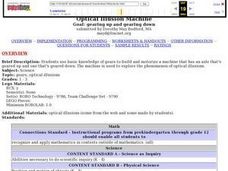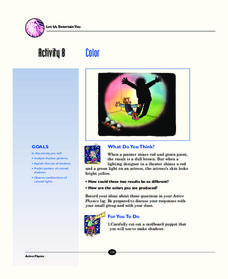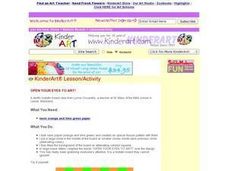Curated OER
Seeing is Believing - Or Is It?
Here is a great science lesson. It extends the concept of vision into the area of optical illusions, perspective, and tessellation. This well-designed plan has tons of great activities, utilizes interesting video, and should lead to a...
Curated OER
Geometric Illusion Banners
Students explore the composition of 3-D optical illusions by analyzing and combining 2-D visual elements graphically in banner form. They dissect the designs to undercover the mathematical elements of the illusion.
Curated OER
Optical Illusions
Students view, identify, and construct four optical illusions. In this optical illusions lesson plan, students are introduced to four types of optical illusions. They construct their own illusions.
National Gallery of Canada
My Upside-Down World!
M.C. Escher is famous for creating optical illusions. Examine this effect in several of his works and discuss the techniques involved. Inspired by the discussion, learners create an imaginary 3-D world inside of a box using various...
Curated OER
Applied Science - Science and Math Post-Lab
Students explore optical illusions. In this Applied Science lesson, students view optical illusions and record the data of what they see. Students graph the data that they collect.
Curated OER
Op Art and Contrast
Seventh graders explore the Op art movement and the work of artists Bridget Riley, Victor Vasarely and MC Escher. the principles of contrast and how it can be used to create optical illusions is examined in this instructional activity.
Curated OER
Optical Illusion Machine
Young scholars explore optical illusions. Using Legos, they construct and motorize a machine that has an axle that's geared up and geared down, complete a worksheet, and answer discussion questions.
Curated OER
Exploring Optical Movement in Art
Students describe, represent and analyze patterns and relationships using shapes. They create simple geometric patterns. They demonstrate increasing technical ability and skill to complete visual arts assignments.
Curated OER
Psychedelic Checkerboard Op Art
Students analyze optical illusions from the packets, both individually and as a class. They create an original optical illusion design using pattern and repetition. They determine which color needs to be in the pattern.
K12 Reader
The Art of M.C. Escher
Show your class one way in which art and math are related by teaching them about M.C. Escher. Class members read a brief passage and then respond to five related questions.
It's About Time
Color
How can a hand puppet's shadow look like a dog? The lesson explains the science behind shadows, combining paint colors and the colors used in old televisions. Scholars use white, red, blue, and green lights to experiment with colors and...
Curated OER
Op Art and Contrast
Seventh graders create Op art designs by reading web information through FlingIt, mapping learned concepts with PicoMap, and creating how-to examples of their own Op art design by using Sketchy. They complete the lesson plan by creating...
Curated OER
Would You Believe Your Eyes?
Learners study the parts and functions of the human eye. They create dodecagons which are twelve-sided figures with twelve equal angles and share these with the class so that each student can begin to see how many different illusions can...
Curated OER
Renkly Relief/Collage Painting
Students study the use of texture, and rhythm as a principle of design when showing movement in a painting.
Curated OER
Text as Texture Collage
Students explore the concepts of rhythm, movement, contrast and texture. They practice using new vocabulary and work on creating a college after designing the arrangement. They self-evaluate their collage and critique their classmates...
Curated OER
Stations of Light
Student groups rotate through four stations to examine light energy behavior: refraction, magnification, prisms and polarization. They see how a beam of light is refracted (bent) through various transparent mediums. Students investigate...
Curated OER
Open Your Eyes To Art!
Students help create a colorful bulletin board for classroom art displays in this short lesson plan for the early elementary classroom. The lesson plan, which can use a variety of items, includes product ideas and resource links to find...
Curated OER
Exploring the Left and Right Sides of the Brain
Explore the Human brain. Students become familiar with the left and right hemispheres of the human brain and engage in activities that activate powers that are dominant in each hemisphere.
Curated OER
Mechanism of Vision
Students explore the eye and its vision. For this science lesson plan, students learn the way light reflected from objects enters the eye, the basic anatomy and physiology of the eye, and the basic mechanism of perception.
Exploratorium
Exploratorium: Shimmer
Student will see this design shimmer! Use this site to learn about this optical illusion and what makes it happen.
Curated OER
Science Kids: Science Images: Life & Death Illusion
This black and white image is a very famous example of an optical illusion. Designed and drawn by C. Allan Gilbert, the name of the image is 'All is Vanity'. It represents both life and death where the meaning of existence is intertwined.
Other
Color Matters
Students learn to understand color from a variety of perspectives: physiology, psychology, philosophy, and art.























